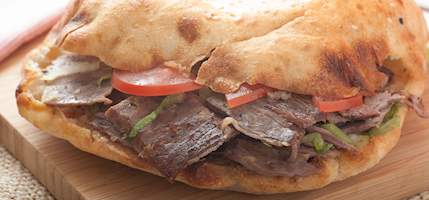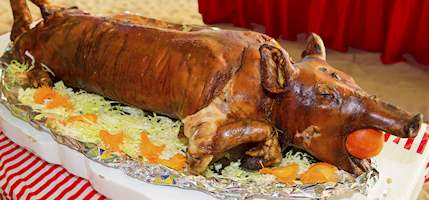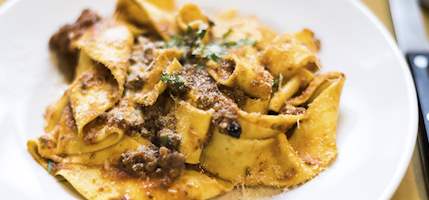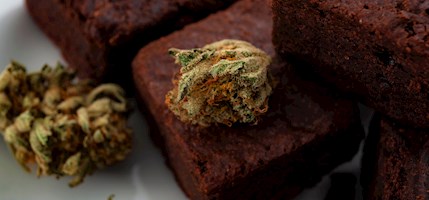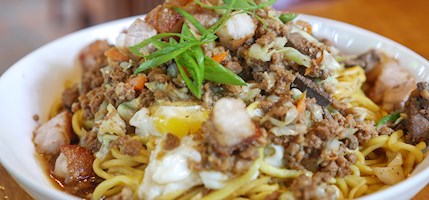Imbuljuta tal-Qastan
Imbuljuta tal-Qastan is a traditional Maltese drink made with chestnuts, cocoa, sugar, tangerine rind, mixed spices, and cloves. Traditionally, it is served piping hot in mugs or small bowls after the midnight mass and on New Year’s Eve. The chestnuts are soaked overnight, drained, rinsed, and then placed back into the saucepan with enough liquid to cover them completely. The rest of the ingredients are then added and brought to a boil. The drink is ready when the chestnuts are soft and tender.
Ġulepp tal-ħarrub
Ġulepp tal-ħarrub is a syrup made from pods of the carob bush, a species of flowering evergreen shrub that is widely used in cooking, often as a replacement for cocoa. In Malta, it's used as a traditional medicine to treat coughing and sore throat. Apart from its medicinal properties, it can also be used as a sweetener and is considered a natural source of iron, phosphorus, natural fibers, and calcium.
Għadam tal-mejtin
Għadam tal-mejtin are traditional bone-shaped Maltese cookies. They consist of a shortcrust biscuit base and an almond filling. The cookies are traditionally prepared and enjoyed for All Souls day. The dough is usually made with a combination of flour, butter, sugar, egg yolks, lemon zest, and vanilla. The filling is made with a combination of ground almonds, icing sugar, and egg whites. Once filled, the cookies are baked in the oven until golden, then topped with icing consisting of icing sugar, water, and almond extract. If stored in a cool and dry place, these bone-shaped cookies can keep for up to a month.
Sfineġ
Sfineġ is a traditional Maltese fritter made with a combination of flour, yeast, salt, warm water, oil, and (optionally) anchovies. When the dough becomes soft, it is left to rest, and it's then combined with anchovies. The fritters are fried in hot oil until golden brown and ready to be eaten. These small fritters are typically prepared and enjoyed during Lent, when meat is forbidden. Nowadays, there are many versions of sfineġ, both sweet and savory.
Klamari mimlija
Klamari mimlija is a traditional dish originating from Malta. The dish consists of stuffed squid. Although every chef has his own recipe, the squid is most commonly stuffed with a combination of onions, garlic, breadcrumbs, ricotta, chopped tentacles, Kalamata olives, parsley, oregano, lemon juice, and olive oil. Once stuffed, the squids are sealed with toothpicks, then baked in the oven until slightly golden on top. The squid is sliced and served warm with tomato sauce and lemon wedges on the side.
Falda mimlija
Falda mimlija is a traditional Maltese dish consisting of stuffed flank steak. The flank is cut open and usually stuffed with a combination of ground pork, chopped bacon, breadcrumbs, onions, eggs, grated cheese, salt, and pepper. Once stuffed, the flank is tied with twine, then slowly simmered with chopped vegetables such as potatoes, carrots, celery, turnip, and onions. After a few hours, the flank is served topped with the vegetable sauce and accompanied by mashed or roasted potatoes on the side.
Bebbux mimli
Bebbux mimli is a traditional pasta dish originating from Malta. The dish is usually made with a combination of lumache (snail-shaped pasta), semolina, ricotta, grated cheese, nutmeg, parsley, eggs, tomato sauce, salt, and pepper. The ricotta is mixed with the eggs, grated cheese, nutmeg, seasonings, and parsley. The pasta is stuffed with the mixture and the open ends are then dipped in semolina so that the lumaconi remain intact while they're cooking. Once the stuffed pasta rises to the top, it's cooked. The stuffed lumaconi are served in warm tomato sauce, toped with grated cheese and a pinch of freshly ground black pepper.
Torta tal-lampuki
Torta tal-lampuki is a traditional Maltese pie made with lampuki as the key ingredient. Also known as dolphinfish or small dorado, lampuki swims in Maltese waters from August until November. When used in torta tal-lampuki, it is combined with olives, spinach, and any other ingredients that can be found in a typical Maltese kitchen – be it onions, tomatoes, capers, or mint. Due to the abundance of local recipes, no torta tal-lampuki pie is the same. The pie is baked until golden brown, and it is recommended to serve it lukewarm, as it may crumble if served straight out of the oven.
Torta tal-irkotta
Torta tal-irkotta is a Maltese pie consisting of a puff pastry or shortcrust pastry base that is filled with a combination of ricotta, goat's cheese, beaten eggs, cream, chopped parsley, and either broad beans or peas. The pie is a favorite with many Maltese people, and it is typically baked until it develops a golden-brown color on the exterior. It is then sliced and (ideally) served with a fresh salad on the side.
Brunġiel mimli
Brunġiel mimli is a traditional dish originating from Malta. The dish consists of stuffed and baked eggplants. The eggplants are washed, cut in half, and boiled. The flesh is removed with a spoon and set aside for later. The eggplants are stuffed with a combination of ground meat (pork, beef, or both), eggs, onions, tomato paste, salt, pepper, grated cheese, and the previously removed eggplant pulp. Once stuffed, they're arranged in a baking dish and baked in the oven for about half an hour, then served.
Qaqoċċ mimli
Qaqoċċ mimli is a traditional dish hailing from Malta. The dish consists of stuffed artichokes. The artichokes are usually stuffed with a combination of crumbled sourdough bread, anchovy fillets, parsley, garlic, olive oil, salt, and pepper. If desired, chopped Kalamata olives can also be added to the stuffing, which is gently pushed in the spaces between the artichoke leaves and in the space where the heart is located. Once stuffed, the artichokes are steamed or simmered in water for about half an hour until tender, and they are then drizzled with olive oil and served immediately.
Laħam taż-żiemel
In Malta, horse meat is regarded as a local delicacy that is occasionally found on the menus of traditional restaurants. The meat is usually prepared as a stew that is marinated and then slowly cooked in a red-wine sauce, typically alongside onions, tomatoes, and various herbs and spices. Horse meat stew is usually paired with roasted potatoes or crusty sourdough bread on the side.
Xiang gan
Xiang gan is a type of dried Chinese tofu, known for its firm texture and ability to absorb flavors well, making it a popular ingredient in various dishes. It is made by pressing a block of firm or extra-firm tofu to remove excess moisture, then baking or frying it until it's thoroughly dried and has a chewy texture. Optionally, it can be marinated in a mixture of soy sauce, five-spice powder, and sesame oil before drying to enhance its flavor. This ingredient is appreciated for its versatility and nutritional benefits, including being a good source of protein for vegetarian and vegan diets.
Session IPA
A Session IPA (India Pale Ale) is a style of beer that merges the hoppy characteristics of a traditional IPA with a lower alcohol content, making it more suitable for extended drinking sessions. Typically, Session IPAs have an alcohol by volume (ABV) ranging between 3% and 5%, significantly lower than the standard IPA, which often has an ABV of 6% to 7.5% or higher. Despite the reduced alcohol content, Session IPAs retain the bold hop flavors characteristic of IPAs, featuring aromatic profiles with notes of citrus, pine, floral, or tropical fruit. The malt backbone is lighter and less sweet, allowing the hops to shine while providing a crisp, refreshing finish. This combination of strong hop flavors and a lighter body results in a beer that is flavorful yet easy to drink, making it ideal for social settings or long afternoons. Session IPAs have gained popularity, especially among craft beer enthusiasts who enjoy the vibrant hop-forward flavors of IPAs but prefer a beer that is less intense and more drinkable. Many breweries now offer Session IPAs as part of their regular lineup, catering to those who seek a flavorful beer without the high alcohol content.
Qaymar
Qaymar (also spelled geymar) is a rich, creamy dairy product commonly consumed in Iraq and other parts of the Middle East. It is similar to clotted cream or kaymak found in Turkey. Qaymar is made by slowly simmering raw buffalo milk (or sometimes cow's milk) until the cream rises to the surface. The cream is then skimmed off and left to cool and thicken into a luscious, velvety layer. Qaymar is traditionally enjoyed as part of breakfast, served with honey, date syrup, or jam, and often paired with flatbread or pastries like kahi in Iraq. It is prized for its luxurious, mildly sweet flavor and smooth, rich texture, making it a favorite in Iraqi households and throughout the region.
Petit Verdot
Petit Verdot is a red wine grape variety known for its deep color, robust tannins, and rich flavors. Originating from the Bordeaux region of France, Petit Verdot is traditionally used as a blending grape in Bordeaux wines, particularly in the Médoc and Graves appellations. Due to its late ripening, it was often challenging to fully mature in Bordeaux's cooler climate, leading to its limited use. However, it has gained popularity in other wine regions with warmer climates, such as California, Australia, and South America, where it can ripen more consistently. Petit Verdot wines are characterized by their intense color and strong tannic structure. The flavor profile typically includes dark fruit notes such as blackberry, black cherry, and plum, along with complex aromas of violet, sage, and leather. As the wine ages, it can develop additional flavors of spice, chocolate, and earthy undertones. In Bordeaux, Petit Verdot is primarily used in small quantities to add color, tannins, and aromatic complexity to blends dominated by Cabernet Sauvignon, Merlot, and Cabernet Franc. Its contribution helps enhance the overall structure and aging potential of the wine. In regions outside of Bordeaux, Petit Verdot is increasingly being produced as a single-varietal wine, showcasing its unique characteristics. These wines tend to be full-bodied with high tannins and acidity, making them suitable for aging. They often require some time in the bottle to soften and develop their full range of flavors. Petit Verdot wines pair well with rich and hearty dishes due to their bold structure and intense flavors. They are an excellent match for grilled or roasted meats, such as beef, lamb, and game, as well as dishes with robust sauces and strong cheeses.
Ħelwa tat-tork
Maltese nut fudge hails from the time when the island was under Arabian rule, and over time it became an important part of local cuisine. Ħelwa tat-tork is made by dissolving tahini and sugar in water to form a dense paste which is then studded with whole roasted almonds. In Malta, this delicious nut fudge is traditionally served after lunch or dinner, and it is typically enjoyed with coffee.
Tal-majjal u patata
Tal-majjal u patata is a traditional casserole originating from Malta. The dish is usually made with a combination of pork, potatoes, onions, garlic, hot peppers, fennel seeds, olive oil, salt, and black pepper. The garlic and onions are sautéed in olive oil. The potatoes and pork are cut into cubes and added into the pan. The ingredients are well stirred, and the hot peppers, fennel seeds, salt, and pepper are then added to the mixture. Some water is added to the dish and it's baked in the oven in a casserole dish until everything is tender and fully cooked.
Bidni
Bidni is an ancient and indigenous Maltese variety of olive known for its unique genetic heritage and high-quality oil production. The name "bidni" comes from the Bidnija area in Malta, where these olives have been traditionally cultivated. The Bidni olive tree is hardy and resistant to harsh weather, pests, and diseases, making it well-suited to Malta's dry Mediterranean climate and rocky soil. The olives are small, dark, and have a distinctive, rich flavor profile. Bidni olives are primarily used for oil production, yielding extra virgin olive oil that is highly regarded for its fruity, peppery, and robust flavor with a slight bitterness. The oil is known for its exceptional quality and high levels of antioxidants. Bidni olives have been grown in Malta for centuries, with evidence suggesting they date back to ancient Roman or even earlier times. The variety is genetically unique, meaning it is found exclusively in Malta, adding to its cultural importance and making it a symbol of Maltese agricultural heritage. Today, Bidni olives are prized for their high-quality oil, which is often marketed as a premium product and celebrated for its health benefits and culinary excellence. The oil pairs beautifully with Maltese bread, salads, and seafood, and it also features in traditional recipes. Efforts are ongoing to protect and promote the Bidni variety, ensuring its preservation as a key part of Malta’s agricultural and culinary identity.
Tombik Döner
Tombik döner or gobit kebab is a variety of döner kebab where the shredded meat is stuffed in a bun-shaped flatbread known as pide ekmek. The bread has a crispy exterior and a soft interior. This dish is typically served with additional ingredients, depending on the customer's choice, such as tomatoes, onions, lettuce, or other assorted vegetables and sauces.
Indigirka Salad
Indigirka is a Russian fish salad that has its origins in Yakutia (Sakha). It consists of diced frozen fish that is combined with onions, oil, salt, and pepper. The salad is typically made from whitefish such as broad whitefish (also known as chir), nelma, and muksun, and it is traditionally served in ice bowls. Indigirka salad first appeared in the middle of the 20th century and was named after the Indigirka River, one of the major Yakutian rivers. It is believed it was created by chef Innokenty Tarbakhov, who based it on a similar ethnic Yakutian dish made with raw fish called raw in the Yakut language or five minutes in Russian. The salad is occasionally accompanied by lemon wedges, but modern variations may include fish roe, fennel, as well as various dressings. This well-chilled appetizer ideally pairs with vodka.
Kutia
Kutia is a Ukrainian, Russian, Belarusian, and Polish sweet grain pudding that is traditionally served as part of a twelve-meal Christmas Eve supper. Interestingly enough, this festive treat is believed to have existed long before Christianity. It is made with wheat, berries, honey or sugar, nuts, raisins, and poppy seeds.On Christmas Eve, before consuming the dish, a small bowl of kutia is traditionally placed outdoors as a bribe to Father Frost, then some of the kutia is tossed to the ceiling, and the number of grains that stick to the ceiling are used to predict next year's agricultural prosperity.
Lechon
Lechon, derived from a Spanish word for roasted suckling pig is one of the most popular dishes in the Philippines. The slowly-roasted suckling pig is usually stuffed with lemongrass, tamarind, garlic, onions, and chives, and is then roasted on a large bamboo spit over an open fire. It is traditionally served whole on a platter, at celebrations and festive events such as weddings and Christmas. Once the meat is properly roasted and falls off the bone, people tend to eat every part of the pig, and the crispy, reddish-brown, crackling skin is especially beloved. Lechon is often served with a thick and rich liver sauce that is cooked with sugar, fresh herbs, and vinegar. If anything is left after the feast, the leftovers are often made into lechon slaw, slowly cooked with vinegar, garlic, and liver sauce for that extra bit of flavor. Apart from the Philippines, the dish is especially popular in countries such as Cuba, Puerto Rico, the Dominican Republic, and Spain. Some famous chefs even named lechon the best pig in the world, so it is definitely worth a try.
Anticuchos
Anticucho is a meat dish consisting of small pieces of skewered and grilled meat, the most popular of them made with beef heart, called anticuchos de corazón. Incan in origin, the dish quickly gained popularity throughout South and Central America. The first written recipe dates back to the 16th century, referring to a meal of marinated llama meat cooked directly over a fire. When the conquistadors encountered the dish, they modified it to make it their own, replacing the llama meat with beef, which was skewered on sugar cane stalks. Today, the meat is typically marinated in red wine vinegar and spices such as garlic, cumin, and aji pepper - developing a fruity flavor when roasted. Anticucho can be found throughout Peru and has spread to other South American countris (especially popular in Bolivia) on numerous street carts and street food stalls, called anticucheras. Typical accompaniments to the dish include corn or boiled potatoes.
Spätzle
Spätzle is the German answer to pasta: thick noodles made from water, salt, flour, and eggs. They are very moist and have a soft texture, so it is not possible to roll them out – instead, they are shaped by hand, with a knife, or pressed through a variety of spätzle-presses. The raw noodles are placed in boiling water and are finished as soon as they float up to the top. The first written recipe for spätzle dates back to 1725, although it is still not known who invented them. Spätzle are used in a variety of dishes and can be combined with ingredients such as cheese, lentils, sausages, sauerkraut, butter, and spinach.
Mila Zagoras Piliou
Mila Zagoras Piliou are apples obtained from the Starking Delicious variety in Zagora, Makrirahi and Pouriou on the eastern side of Pilios. The systematic cultivation of these apples started in the 1960s under the supervision of the Zagora Agricultural Cooperative. They owe their distinctive characteristics to high altitudes where they are grown, special weather conditions and the use of traditional cultivation techniques. Mila Zagoras Piliou are harvested by hand after their ripeness is checked. Following the quality assessment, they are packed and stored in the cooperative's modern installations. They can be recognized by their vivid red color and a smooth, waxy skin. Their flesh is white to yellow, very juicy and full of flavor.
Dacquoise
Both crispy and creamy in texture, this French cake is traditionally made with almond or hazelnut meringue sponge cake separated with layers of whipped cream or buttercream. The cake takes its name from the French word dacquois, meaning from Dax, referring to a town located in southwestern France, but the term dacquoise itself has come to signify any dessert with layers of nut meringue sponge cake. The cake is believed to have originated in the 17th century, when it was invented as a luxurious dessert for the people of the French court. The recipe later became very popular in England, after numerous French chefs moved there to cook for the upper class. Its huge popularity generated a wave of different versions of the cake, such as the infamous marjolaine, a rectangular variety of dacquoise known as the mother of all French desserts, which is made with meringue sponge cake and chocolate buttercream.
Pappardelle al cinghiale
Pappardelle is a famous Tuscan pasta variety. When paired with ragù di cinghiale (made with wild boar), they become one of the region's best gastronomic experiences. Unlike classic ragù, the one prepared with wild boar has an intense, much stronger flavor achieved by long, slow simmering in a rich sauce of tomatoes and red wine. The tender meat paired with fresh egg pasta is a combination full of flavors and tradition in every single bite - rich and delicious, topped with a generous amount of chopped fresh parsley and a sprinkle of Parmigiano, pappardelle al ragù di cinghiale make a perfect, comforting winter dish, especially when paired with a glass of Tuscan red wine.
Chicha morada
Chicha Morada is a non-alcoholic drink originating from Peru whose use and consumption dates back to the era before the creation of the Inca empire. It is traditionally made by boiling purple corn and pineapple rinds in water, and once all the juices have gotten into the water, the combination is left to cool down. Sugar, cinnamon, and cloves can be added later for extra flavor. This simple drink can be found in street markets as well as in upscale restaurants and home kitchens throughout Peru and Bolivia.
Space Cake
ALTHOUGH THERE ARE CLAIMS THAT EATING SPACE CAKES CAN LEAD TO PSYCHOSIS OR PSYCHOSIS SYMPTOMS FOR SOME PEOPLE, THERE'S STILL NOT ENOUGH CONCLUSIVE SCIENTIFIC EVIDENCE TO SUPPORT THEM. Originating from Amsterdam, space cake is a notorious delicacy that belongs to a group of cannabis-infused edibles. Variations on this specialty abound, and any baked good that contains cannabis butter may be called a space cake. This Dutch specialty is usually prepared with typical cake ingredients such as flour, sugar, baking powder, butter, milk, and eggs, which are combined with a certain quantity of cannabis. A great variety of ingredients can be added to the base to enrich the cake, including cocoa powder, chocolate drops, dried fruit, buttercream, vanilla, or various spices, and the baked cakes often come dusted with powdered sugar, glazed, soaked in rum, or stuffed with cream or custard. As with other cannabis intake methods, the consumption of cannabis in the form of space cakes also provides psychotropic effects upon its consumers due to the presence of THC (tetrahydrocannabinol) and other compounds. In the case of space cakes, the effects are usually prolonged and much stronger, and consumers typically feel high within 3 hours from the consumption. Space cakes with different shapes, flavors, and varying strengths can be savored at nearly any coffee shop in Amsterdam and they’re typically enjoyed alongside a cup of coffee, herbal tea, or beer. When it comes to the legal status of these cakes in the Netherlands, the country’s court allows the sale only of those cakes that are made with crushed weed.
Pancit Batil Patong
Pancit Batil Patong is a traditional type of Filipino pancit originating from Tuguegarao City in Cagayan. The dish consists of two main elements – noodles with toppings, and a sauce. The first part is made with a combination of egg noodles, ground beef or water buffalo meat, pork liver, onions, mung bean sprouts, scallions, cabbage, carrots, eggs, soy sauce, black pepper, and oil, while the sauce is made with beef stock, eggs, carrots, onions, and celery – the final result should look similar to egg drop soup. Once prepared, the sauce is poured over the noodles and meat, and the dish is enjoyed while still warm. There are many variations on the dish, so it's often served with an egg on top, while lemon or calamansi wedges are often served on the side.
Tahini
Tahini is a paste consisting of toasted and ground sesame seeds which are usually thinned with lemon juice and water. It is an incredibly versatile paste that can be served as a dip and consumed on its own, or as a condiment accompanying numerous meat and vegetable dishes in Middle Eastern cuisine. Tahini can also be used as a spread, as the main ingredient in soups, or as a key ingredient in hummus, halva, or baba ghanoush. It is believed that the best tahini should have a light and toasty sesame seed flavor and a rich texture. The paste contains large amounts of Vitamin B and E, as well as magnesium, iron, and calcium. Originally, sesame seeds came to Israel via ancient Persia, where they were considered holy food. Sesame products were so popular that they were reserved only for the aristocracy, and tahini soon spread to India, Africa, and Asia. Today, it remains an extremely popular condiment in numerous countries such as Greece, Iraq, Turkey, Syria, and Egypt. It is recommended to pair it with date syrup or cocoa powder for a nutritious, flavorful dessert.
Bougatsa
Bougatsa is a traditional, rustic Greek pie consisting of a phyllo pastry layered with a filling of semolina custard, although there are variations with minced meat or cheese. The name of the dish is a derivation of the Ottoman word pogatsa, denoting a pie filled with cheese. Bougatsa has origins from the Byzantine period, when Constantinople was Greek, and it began as a dough that was stuffed with numerous sweet and savory fillings. Over time, bougatsa evolved to incorporate a thinly rolled, hand-made phyllo pastry. As many Turkish immigrants settled in Northen Greece, bougatsa became a specialty of Serres and Thessaloniki. Today, the pies can be found throughout Greece in specialty shops called bougatsopolia, selling bougatsas exclusively.
Hummus
This internationally popular, beige-colored spread is traditionally made with mashed chickpeas, tahini sesame paste, lemon juice, and garlic. People across the world love hummus for its tangy flavor and the fact that it is filled with nutrients. When served, it is typically dressed with a drizzle of olive oil, and is then used as a dip for vegetables or a flavorful filling for flatbreads such as pita. Even today, not much is known about its origins, although the earliest mention of hummus dates back to 13th-century Egypt. Hummus is sometimes additionally enriched with spices such as cumin and paprika, and it can be garnished with anything from fresh herbs, cucumbers, and chopped tomatoes to olives, pine nuts, and hard-boiled eggs.
Thanksgiving Dinner
For most Americans, the Thanksgiving dinner usually includes seasonal dishes such as stuffed roasted turkey and side dishes such as mashed potatoes, a rich cranberry sauce, and pumpkin pie, among others. This celebratory meal dates back to November 1621, when the Pilgrims and the Native Wampanoag Indians got together at Plymouth for an autumn harvest celebration, now considered America's first Thanksgiving. The first feast contained turkey (debatable), venison, fish, clams, berries, lobster, pumpkin, waterfowl, and squash, and many of the foods remained a staple of modern Thanksgiving dinners. Turkey is so synonymous with the holiday that the day is sometimes colloquially called Turkey Day. Today, the dinner centers on cooking and sharing a plentiful meal with close family and friends, and it is so popular that there are annual Thanksgiving parades throughout the United States, the largest and most famous of them being Macy's parade in New York City, featuring marching bands, floats, and performers, and attracting about two to three million spectators to the streets.
Krémes
The Hungarian version of the famous cremeschnitte goes under the name krémes, meaning creamy. It combines two layers of puff pastry held together with a generous amount of smooth pastry cream. Though the recipe has been slightly modernized, the classic krémes pastry cream should be light and airy, while the top is usually dusted with powdered sugar. Traditionally served cut into large, rectangular slices, the dessert is a Hungarian classic and a staple at numerous pastry shops throughout the country.
Sacher-Torte
The original Sacher-Torte is the most famous Austrian cake. It is a classic, layered chocolate sponge cake that is thinly coated with high-quality apricot jam and topped with chocolate icing. Sacher-Torte is said to taste the best when accompanied by a small cloud of unsweetened whipped cream on the side. It was invented in 1832 by Franz Sacher, a pastry chef for Prince Clemens Lothar Wensel Metternich, the State Chancellor of Austria at the time. The prince wanted a new cake, and Sacher, 16 years old at the time, obliged him by creating something new from ingredients that were readily available in the kitchen. Suffice to say, the cake was a huge hit, and Franz's son Eduard opened a hotel called Sacher in 1876, serving the popular cake up to this day. Today, almost every coffee house in Vienna has its own version of the cake, but no two cakes are quite alike. In order to avoid confusion, it is recommended to look for the official Sacher chocolate seal on top of the cake, which can only be found on the Original Sacher, produced by Hotel Sacher in a quantity of approximately 360,000 cakes per year. Interestingly, from 1954 to 1963, Hotel Sacher went through a legal battle with their rival, Demel cafe, and the court proceedings focused on which one had the right to call its Sacher-Torte the original. The issues that were discussed included whether the cake should have an additional layer of apricot jam in the middle, and whether to use margarine or butter. Following a long seven-year dispute, the parties have reached an agreement—and the original Sacher-Torte is now only found at the Hotel Sacher. Nevertheless, Demel version, which does not have the additional layer of apricot jam in the middle, is almost equally popular.
Roti tisu
Roti tisu is the paper thin variety of the traditional Malay roti canai. It is prepared with the same type of dough that is stretched thin, sometimes up to five or six feet in length, and it is then shortly pan-fried. Tisu is served wrapped around a large cone, hence its alternative name rocket roti or roti helicopter. It can be served alongside curries or chutneys, but it is usually enjoyed as a dessert or a sweet snack, when it comes drizzled with condensed milk or chocolate, dusted with sugar, or sided with ice cream or fruit jams. A staple at Mamak restaurants and stalls throughout Singapore and Malaysia, roti tisu is usually eaten by cracking small pieces of delicate pastry with your hands.
Hessischer Handkäse
The name and the size of Hessen Handkäse are both derived from its traditional manufacturing method, in which the cheese was molded by hand. Handkäse is a German regional sour milk cheese produced in Frankfurt Rhine-Main and Rheinhessen. It has a fat content of less than 1% and an impressive protein content of 25%. Hessen Handkäse is a delicious cheese with quite a pungent aroma, and it is usually served sprinkled with caraway seeds and topped with sliced onions. Traditionally, this cheese is served either plain or as 'Hessen Handkäse mit Musik', seasoned with salt and pepper and marinated with onions in oil and vinegar, occasionally with some water or a dash of cider or wine added to the marinade.


























